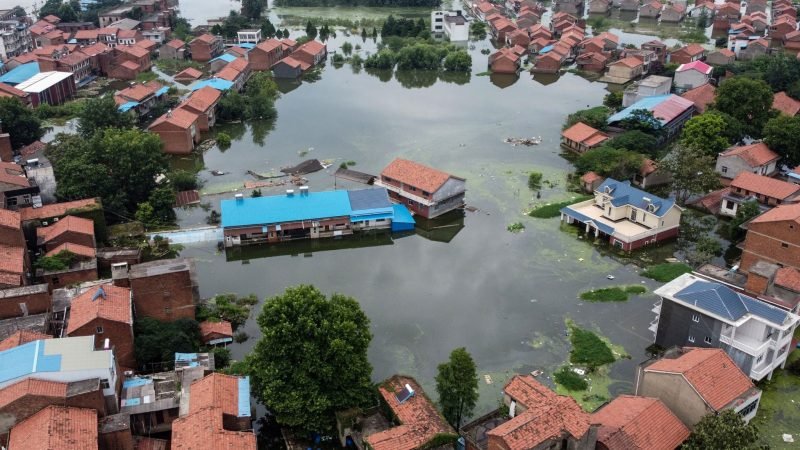Yangtze basin Floods: Disrupting Chinese Lives

“Water is fluid, soft, and yielding. But water will wear away rock, which is rigid and cannot yield. As a rule, whatever is fluid, soft, and yielding will overcome whatever is rigid and hard. That is another paradox: what is soft is strong.”
~Lao Tzu
The Yangtze basin and its tributaries have been flooded due to the heavy rains and have impacted the Southern, Eastern and Central China. The Central Meteorological Observatory stated that since June, the aggregate rainfall in the four provinces in the middle and lower reaches of the Yangtze River in China has surpassed records since 1961. As of July 17, the “Yangtze River 2020 No. 2 Flood” has formed in the upper reaches of the Yangtze River. The water level of Taihu Lake has been over-alarmed for 19 consecutive days.

Sichuan, Guizhou and Chongqing provinces in the Southwest and Hubei province in Central China were the first to be hit by the flash floods in the late June. China’s Ministry of Water Resources reported that the water level is above the risk in more than 80 locations. The heavy rainfall recently in the region has swollen rivers and lakes, causing flash flooding and landslides. Large areas of Eastern China experienced between 400 mm and 600 mm of rain in the first 10 days of July, according to statistics from China’s Meteorological Agency (CMA).

1/6 of the country’s rainfall exceeds 200 mm, such rainfall has been described as “splashing water” by China Weather
National Defense Office, Emergency Management Department has reported that the floods have affected 37.89 million people in 27 provinces with more than 141 dead and missing, and of direct economic loss of RMB 86 billion (equivalent to US$ 12.3 billion). The flooding has destroyed 27,000 buildings. State Flood Control and Drought Relief headquarters have raised China’s flood response level from Level III to Level II, the second-highest level.
Qingjia, a journalist in Financial Times in China communicated, “There is no concept by just looking at the numbers. But one of the tea farmers in Shexian County suffered 90 million losses due to flooding of the tea leaves.”
Also, Sun Jie- an instructor at Shangrao Municipal fire brigade told that “We have been rescuing people non-stop since July 9. The water level rose quickly. The floods have destroyed the houses. We have evacuated most of the citizens now”.
In 2020, more painful than the COVID-19 pandemic has been this flood. The Central city of Wuhan, Anhui, Jiangxi and Zhejiang provinces have declared red alerts. The floods have disturbed the supply of the equipment required for fighting the coronavirus, including Personal Protective Equipment (PPE). Not only inside the country, but the supply chain of the equipment outside of China has also been disrupted.

The dams and reservoirs have been regulated in different provinces to ease the rising water level. On July 19th, the Chinese authorities blew up a part of a dam in eastern Anhui province to ease the rising water level pressure because of the heavy rainfall. This is expected to reduce the level of Chu River by around 70 centimetres (about 29 inches). The Xin’anjiang Reservoir conducted a nine-hole flood discharge for the first time in its history. Authorities are mainly concerned with Poyang Lake, China’s largest freshwater lake in hard-hit Jiangxi province and which has prompted a massive evacuation in the several Central regions of China.
The urban cities are also been affected by the floods, the roads have been turned into rivers. Dams along the waterways connected to the Yangtze River have been blown up to reduce high water levels. The Three Gorges Dam opened its 5 flood gates after the levels rose to 163.59 meters more than 18.59 meters above the flood limit in 18th July. The rapid inflow of water to the dam rose to 61 thousand cubic meters per second in the morning of 17th July. The flooding occurs every year, but experts have mentioned that climate change is making it worse every year.
Song Lianchun of China’s National Meteorological Center said, “Our observational study shows that global climate changes have led to extreme weather in some regions and our country is located in the area that is sensitive to the climate change.”
Chinese President Xi Jinping has urged local governments and Communist Party of China’s members to take responsibility in flood-triggered disaster prevention and relief work. Xi stressed that flood prevention and disaster relief are interrelated to people’s protection and lives, food security, economic and social security and national security.
Though this year has been as worst for China because of coronavirus and recent floods, hope this natural flooding will not be devastating as the floods in China in 1931 and 1998, where millions of lives were lost. Though the big dams have been constructed in China, she must think of more than building dams and focus on the human activities and climate change that are considered to be the reasons for severe floods every year.


















